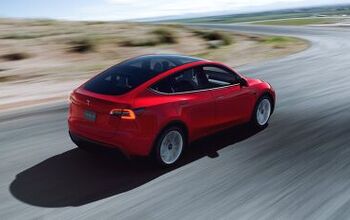General Motors Hips Early EV Adopters to Potential Battery Failure in the Bolt

General Motors has informed a small number of owners of its Chevrolet Bolt EV about a battery issue that could cause a sudden loss of propulsion. Some of the early Bolt models may incorrectly report the estimated remaining range at lower states of charge due to potentially faulty cells, resulting in the car stopping abruptly.
The automaker says less than 1 percent of Bolts sold to date are likely to face the problem, and GM is currently arranging repairs for the affected cars. Ideally, the faulty cells are the result of an isolated manufacturing defect and not the result of some widespread wonky battery chemistry.
In an interview with PluginCars, Kevin Kelly, senior manager for advanced technology communications at General Motors, explained the solution would be to replace the entire battery pack, even if only one cell turned out to be faulty.
“We noticed an anomaly via data from OnStar and that led us to investigate the issue,” explained Kelly.
GM stated that the voltage problem is caused by one or more of the cells malfunctioning and thereby providing a false reading of remaining range on the dashboard. Drivers could then mistakenly believe the Bolt’s spoiled battery pack has sufficient charge to complete a journey — only to find themselves stranded before reaching their destination.
PluginCars’ Brad Berman was also one of the claimed few affected by the voltage issue. His Bolt indicated a 100-mile range before issuing a warning chime, shuddering, and coming to a complete stop while on the road. At this point, the vehicle indicated 9 miles of possible range but wouldn’t allow itself to be placed in any gear except neutral or park.
Berman was also clear that the “behavior of the vehicle was not like driving an EV with a depleted battery.” Typically, EVs that have nearly exhausted their power enter into a limp mode that reduces power for the sake of maximizing a now-limited range. Instead, the Bolt issued a short alert and abruptly stopped in the middle of the road — forcing the driver to push it to safety.
He stated it took the service center roughly two days to diagnose the problem. This was due to a limited supply of EV specialists and other Bolts already queued for servicing at the local dealership. As a result of the que, it took nearly two weeks to replace the battery pack. Berman also said he was surprised to learn GM considered his vehicle an early production model, as he had leased it roughly six months after deliveries began in North America.
[Image: General Motors]

A staunch consumer advocate tracking industry trends and regulation. Before joining TTAC, Matt spent a decade working for marketing and research firms based in NYC. Clients included several of the world’s largest automakers, global tire brands, and aftermarket part suppliers. Dissatisfied with the corporate world and resentful of having to wear suits everyday, he pivoted to writing about cars. Since then, that man has become an ardent supporter of the right-to-repair movement, been interviewed on the auto industry by national radio broadcasts, driven more rental cars than anyone ever should, participated in amateur rallying events, and received the requisite minimum training as sanctioned by the SCCA. Handy with a wrench, Matt grew up surrounded by Detroit auto workers and managed to get a pizza delivery job before he was legally eligible. He later found himself driving box trucks through Manhattan, guaranteeing future sympathy for actual truckers. He continues to conduct research pertaining to the automotive sector as an independent contractor and has since moved back to his native Michigan, closer to where the cars are born. A contrarian, Matt claims to prefer understeer — stating that front and all-wheel drive vehicles cater best to his driving style.
More by Matt Posky
Latest Car Reviews
Read moreLatest Product Reviews
Read moreRecent Comments
- Analoggrotto Maybe Eminem will buy it.
- Analoggrotto I did a dozen or so laps around Atlanta Motorsports Park for a charity once. Camber and toe on my car were horribly wrong and made the entire experience awful.
- Tassos Jong-iL The Peninsula of One Korea.
- Eric No, I just share my opinions. I have no use nor time for rhetoric from any side.
- Redapple2 Jeez. This is simple. I 75 and 696 area. 1 nobody -NOBODY wants to work in downtown Detritus. 2 close to the tech ctr. Design and Engineering HQ. 20 miles closer to Milford.3 lower taxes for the employees. Lower taxes for Evil GM Vampire.4 2 major expressways give users more options to suburbs. Faster transport.Jeez.

































Comments
Join the conversation
This is the problem when a car needs 87 micro-controllers to dance in perfect harmony for the car to operate. Used to be if you had spark, fuel, and compression the car would run. Those days are gone. (Cue the obligatory posts about how modern cars are more reliable then ever, blah blah, blah.) . .
"Hips" How exactly did GM hip Bolt owners.